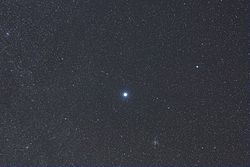| NGC 2360 | |
|---|---|
 SDSS SDSS | |
| Observation data (J2000 epoch) | |
| Right ascension | 07 17 43 |
| Declination | −15° 38′ 29″ |
| Apparent magnitude (V) | 7.2 |
| Apparent dimensions (V) | 13′ |
| Physical characteristics | |
| Other designations | Caroline's Cluster, Caldwell 58, Cr 134, Mel 64 |
| Associations | |
| Constellation | Canis Major |
| See also: Open cluster, List of open clusters | |

NGC 2360 (also known as Caroline's Cluster or Caldwell 58) is an open cluster in the constellation Canis Major. It was discovered on 26 February 1783 by Caroline Herschel, who described it as a "beautiful cluster of pretty compressed stars near 1/2 degree in diameter". Her notes were overlooked until her brother William included the cluster in his 1786 catalogue of 1000 clusters and nebulae and acknowledged her as the discoverer. The cluster lies 3.5 degrees east of Gamma Canis Majoris and less than one degree northwest of the eclipsing binary star R Canis Majoris; it has a combined apparent magnitude of 7.2. It is 13 arc minutes in diameter. By the western edge of the cluster is the unrelated star, 5.5-magnitude HD 56405.
American astronomer Olin J. Eggen surveyed the cluster in 1968, concluding that the brightest star in the field, magnitude-8.96 HD 56847, is likely to lie in the field and not a true member of the cluster. He also identified one or possibly two blue stragglers. These are unexpectedly hot and luminous stars that appear younger than surrounding stars, and have likely developed by sucking matter off companion stars. Four are now recognised to be in the cluster. By analysing the masses of the smallest stars that have evolved into red giants—namely, stars of 1.8 or 1.9 solar masses—Swiss astronomers Jean-Claude Mermilliod and Michel Mayor were able to date the age of the cluster at 2.2 billion years. The cluster has a diameter of around 15 light-years and is located 3700 light-years from Earth.
 Sirius and M41 (lower right), M50 (upper left), and NGC 2360 (lower left) |
Notes
- ^ "Results for NGC 2360". NGC/IC Project Database. Archived from the original on 2012-05-20. Retrieved 2010-12-03.
- ^ "SEDS Online NGC Database". Results for NGC 2360. Retrieved 2010-12-03.
- ^ "NGC 2360". SIMBAD. Centre de données astronomiques de Strasbourg. Retrieved 2010-12-03.
- ^ Hoskin, Michael (2005). "Caroline Herschel as observer" (PDF). Journal for the History of Astronomy. 36 (4): 373–406. Bibcode:2005JHA....36..373H. doi:10.1177/002182860503600402. S2CID 118428465.
- ^ O'Meara, Stephen James (2002). The Caldwell Objects. Cambridge University Press. pp. 231–33. ISBN 978-0-521-82796-6.
- Streicher, Magda (April 2006). "Caroline Herschel's Deepsky Discoveries" (PDF). Deepsky Delights. The Astronomical Society of Southern Africa. pp. 234–36. Retrieved 16 March 2014.
- Eggen, Olin J. (1968). "The Intermediate-Age Cluster NGC 2360" (PDF). The Astrophysical Journal. 152: 83–87. Bibcode:1968ApJ...152...83E. doi:10.1086/149526.
- Fellman, Megan (17 October 2011). "Astronomers Explain 'Blue Stragglers'". News. Evanston, Illinois: Northwestern University. Retrieved 18 March 2014.
- Ahumada, J. A.; Lapasset, E. (2007). "New catalogue of blue stragglers in open clusters". Astronomy and Astrophysics. 463 (2): 789–97. Bibcode:2007A&A...463..789A. doi:10.1051/0004-6361:20054590.
- Mermilliod, Jean-Claude; Mayor, Michel (1990). "Red Giants in Open Clusters. III – Binarity and Stellar Evolution in Five Intermediate-age Clusters: NGC 2360, 2423, 5822, 6811, and IC 4756" (PDF). Astronomy and Astrophysics. 273 (1): 61–72. Bibcode:1990A&A...237...61M.
External links
- NGC 2360 on WikiSky: DSS2, SDSS, GALEX, IRAS, Hydrogen α, X-Ray, Astrophoto, Sky Map, Articles and images
| Astronomical catalogs | |
|---|---|
| NGC | |
| Caldwell | |
| Collinder | |
| Caldwell catalogue | |
|---|---|
| List |
|
| See also | |
| Constellation of Canis Major | |||||||||||||
|---|---|---|---|---|---|---|---|---|---|---|---|---|---|
| Stars |
| ||||||||||||
| |||||||||||||
| Star clusters |
| ||||||||||||
| |||||||||||||
| Galaxies |
| ||||||||||||
| |||||||||||||